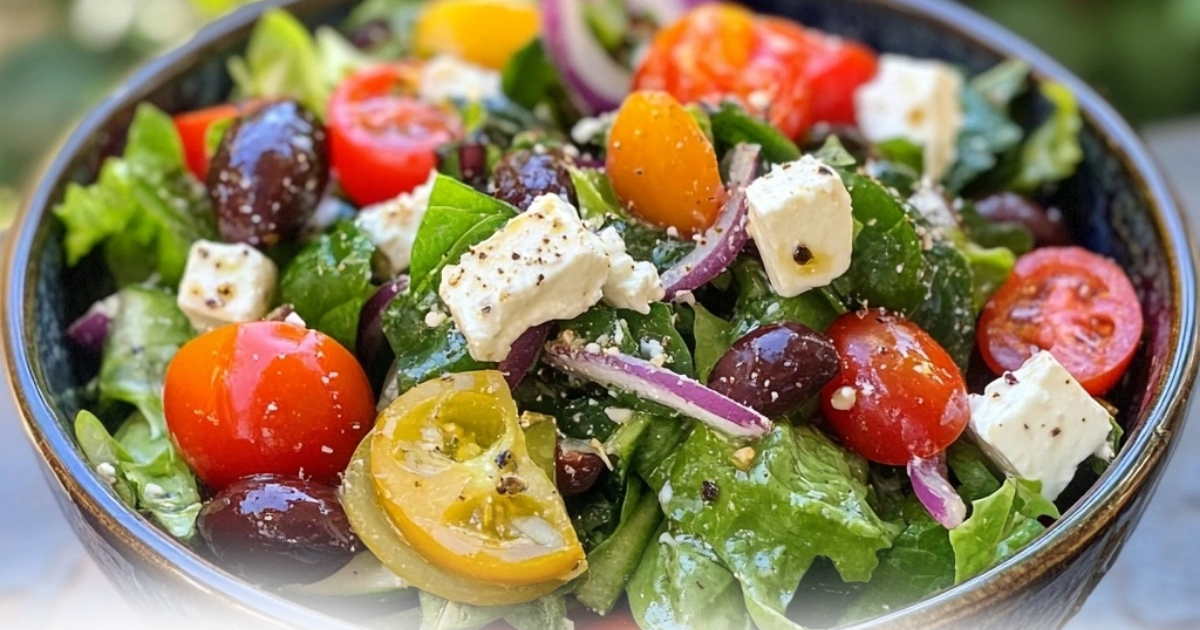Before we dive into the world of traditional Greek salad, known in Greece as “Horiatiki,” let’s focus on its main components. What is a traditional Greek salad made of?At first glance, it seems simple—fresh veggies, olives, and feta—but its story and preparation hold much more. This Mediterranean favorite offers rustic origins, local twists, and secrets to creating the perfect balance of flavors. We’ll cover every aspect, from its ingredients to its health benefits, and share tips on how to easily include it in your meals for a delightful experience.
Table of contents
Core Ingredients of a Traditional Greek Salad
Essential Components: Tomatoes, Cucumbers, and Feta
Central to every traditional Greek salad are its vibrant, fresh ingredients. What is a traditional Greek salad made of? Well, it starts with juicy, ripe tomatoes that add a splash of color and a sweet yet tangy flavor. Crisp cucumbers follow, contributing a refreshing crunch that contrasts delightfully with the softness of the tomatoes. The salad is then crowned with a thick slice of feta cheese, whose creamy, salty profile enriches the overall simplicity of the dish. This cheese isn’t just a topping; it’s a cornerstone that brings the vegetables together in harmony.

Role of Olives and Olive Oil
No Greek salad would be complete without the presence of olives—typically Kalamata, which are known for their rich, deep flavor and meaty texture. These olives add a touch of bitterness that balances the salad’s fresher elements. Drizzled generously over the top is extra virgin olive oil, lending a smooth, fruity flavor that ties all the ingredients together. This oil is not just a dressing but a crucial ingredient that enhances the natural flavors of the vegetables and cheese.

Optional Additions Across Different Regions
While the basic ingredients of a Greek salad remain consistent, regional variations introduce a range of optional additions that reflect local tastes and agricultural products. In some areas, green bell peppers slice into the mix, adding a mild, sweet flavor. Capers, parsley, and red onions are also popular additions in various parts of Greece, each lending its unique taste and texture, making every regional version of the salad distinct yet unmistakably Greek.
How to Prepare a Classic Greek Salad
Step-by-Step Preparation Guide
Preparing a traditional Greek salad is straightforward. Start by slicing the tomatoes into wedges and the cucumbers into thick half-moons. Slice the red onions into thin rings. Arrange these ingredients in a large bowl or on a platter. Add whole or pitted Kalamata olives and capers if you like. Top with a thick slab of feta cheese. Instead of mixing, keep the feta as a large block to maintain its texture until serving.

Tips for Choosing the Right Ingredients
The key to an excellent Greek salad lies in the quality of its ingredients. Choose the juiciest tomatoes and the crispest cucumbers. Buy feta cheese in blocks, preferably made from sheep’s milk and soaked in brine for that authentic tangy taste. When selecting olive oil, opt for a high-quality extra virgin variety. This not only adds flavor but also offers health benefits. Assemble your salad with minimal seasoning—just a sprinkle of sea salt and dried oregano to enhance the natural flavors.
Nutritional Benefits of Greek Salad
Analysis of Health Benefits
A traditional Greek salad is a nutritional powerhouse. The ingredients—tomatoes, cucumbers, olives, and feta—supply essential nutrients. Tomatoes provide vitamins C and K, potassium, and folate. Cucumbers offer hydration while being low in calories. Olives are rich in healthy fats and antioxidants, promoting heart health. Feta adds calcium and protein. Together, these components make Greek salad a valuable part of the Mediterranean diet, known for enhancing longevity and reducing heart disease risks.
Caloric and Nutritional Content Breakdown
A serving of Greek salad contains about 200-300 calories, depending on the amounts of olive oil and feta used. It’s low in carbohydrates and high in dietary fiber, aiding in digestion. The salad also offers a healthy dose of monounsaturated fats from olive oil, crucial for managing good cholesterol levels. Greek salad is a smart choice for those seeking a balance of nutrients without excessive calories.
Regional Variations of Greek Salad
Differences in Ingredients by Region
While the core of a traditional Greek salad remains the same, regional variations bring unique twists. What is a traditional Greek salad made of? It typically includes tomatoes, cucumbers, onions, olives, and feta cheese. However, in some regions of Greece, locals add ingredients that reflect their traditions. In Northern Greece, capers or red peppers are often included. These additions bring a new layer of flavor to the salad.
Special Versions from Islands Like Crete and Mykonos
Greek islands offer exciting takes on the classic salad. In Crete, people often include barley rusks, creating a heartier version called Dakos. This variation replaces feta with crumbled mizithra cheese, a soft local cheese. On the island of Mykonos, a summer twist features watermelon instead of tomatoes. The sweetness of the fruit contrasts beautifully with the salty feta, offering a refreshing treat.

These versions highlight the adaptability of Greek salad. Each region adds its own flair while preserving the essence of this beloved dish. Whether you stick to the classic or explore these variations, the heart of the Greek salad always shines through—simple, fresh ingredients that celebrate Mediterranean flavors. Be sure to check out our Greek cuisine collection.
Nutritional Benefits of Greek Salad
Analysis of Health Benefits
A traditional Greek salad isn’t just a feast for the senses; it’s also a powerhouse of nutritional value. The key ingredients—tomatoes, cucumbers, olives, and feta—each bring essential nutrients to the table. Tomatoes are a great source of vitamins C and K, potassium, and folate, while cucumbers keep things low in calories but high in hydration. Olives, particularly Kalamata, are rich in healthy fats and antioxidants, supporting heart health. Feta cheese adds a good dose of calcium and protein. Together, these ingredients make Greek salad a beneficial part of the Mediterranean diet, known for promoting longevity and reducing risks of heart diseases.
Caloric and Nutritional Content Breakdown
What is a traditional Greek salad made of in terms of its nutritional impact? Typically, a serving contains about 200-300 calories, but this can vary depending on the amount of olive oil and feta cheese used. It’s low in carbohydrates and high in dietary fiber, which helps in maintaining a healthy gut. The salad also provides a healthy dose of monounsaturated fats from the olive oil, which are crucial for maintaining good cholesterol levels. For those looking to maintain a balanced diet, Greek salad offers a satisfying way to consume a variety of nutrients without excessive calories.
Advanced Tips for the Perfect Greek Salad
Choosing the Right Produce
The freshness of the ingredients can make or break a Greek salad. To elevate your dish:
- Opt for heirloom tomatoes for a burst of flavor and color.
- Use Persian cucumbers for their thinner skin and sweeter taste.
- Select olives cured in olive oil or vinegar for the most authentic flavor.
Presentation Matters
For a visually appealing presentation, layer the vegetables in a clear bowl or serve on a wooden platter. Add the block of feta on top, drizzle with olive oil, and garnish with fresh oregano leaves.
Pairing and Serving Suggestions
Ideal Combinations with Other Greek Dishes
Greek salad pairs perfectly with many traditional dishes. Serve it with grilled meats like souvlaki or lamb chops for a balanced meal. It also complements rich dishes like moussaka, as the salad’s freshness offsets heavier flavors. For a lighter option, pair it with spanakopita, a flaky spinach and feta pie. The crisp vegetables and salty feta make a great side for seafood, too.
Suggestions for Incorporating Greek Salad into Meals
The versatility of Greek salad makes it an excellent choice for any meal. It can stand alone as a light, satisfying lunch or serve as a colorful side to dinner. Beyond traditional pairings, try incorporating it into a wrap with grilled chicken for a nutritious, easy-to-make lunch. Additionally, it can be a festive addition to any picnic or barbecue, brightening the table with its Mediterranean flair.
FAQs About Greek Salad
Common Questions and Expert Answers
What is a traditional Greek salad made of? Typically, it includes tomatoes, cucumbers, red onions, Kalamata olives, and feta cheese, seasoned with salt, oregano, and dressed with olive oil. Variations might include capers or bell peppers, depending on the region. How should I store leftover Greek salad? It’s best eaten fresh, but leftovers can be stored in the refrigerator for up to two days. Can I make a Greek salad without feta cheese? Yes, for a dairy-free version, simply omit the feta or substitute it with a vegan cheese alternative to enjoy a similar flavor profile.
Conclusion: The Timeless Appeal of Greek Salad
Exploring the traditional Greek salad, or Horiatiki, shows us much more than just the mix of ingredients in this colorful dish. What is a traditional Greek salad made of? It’s a mix of fresh vegetables, quality olive oil, and strong feta cheese, each adding its own flavor to this simple but meaningful dish. More than just ingredients, the Greek salad represents a way of life—simple, fresh, and deeply rooted in tradition but adaptable and enduring over time.
As we’ve seen, this dish is a key part of Greek cuisine but also a symbol of the health benefits and cultural importance of the Mediterranean diet. Whether it’s served as part of a family meal, a quick lunch, or a lavish feast, Greek salad remains a favorite around the world, loved for both its taste and nutritional value.
In the end, the Greek salad is more than a dish; it’s a celebration of Greek heritage and culinary simplicity, a refreshing reminder that sometimes, the best things in life come in the simplest packages. As you enjoy the flavors and traditions of Greek salad, you join a timeless culinary tradition that continues to bring people together, one delicious bite at a time.

